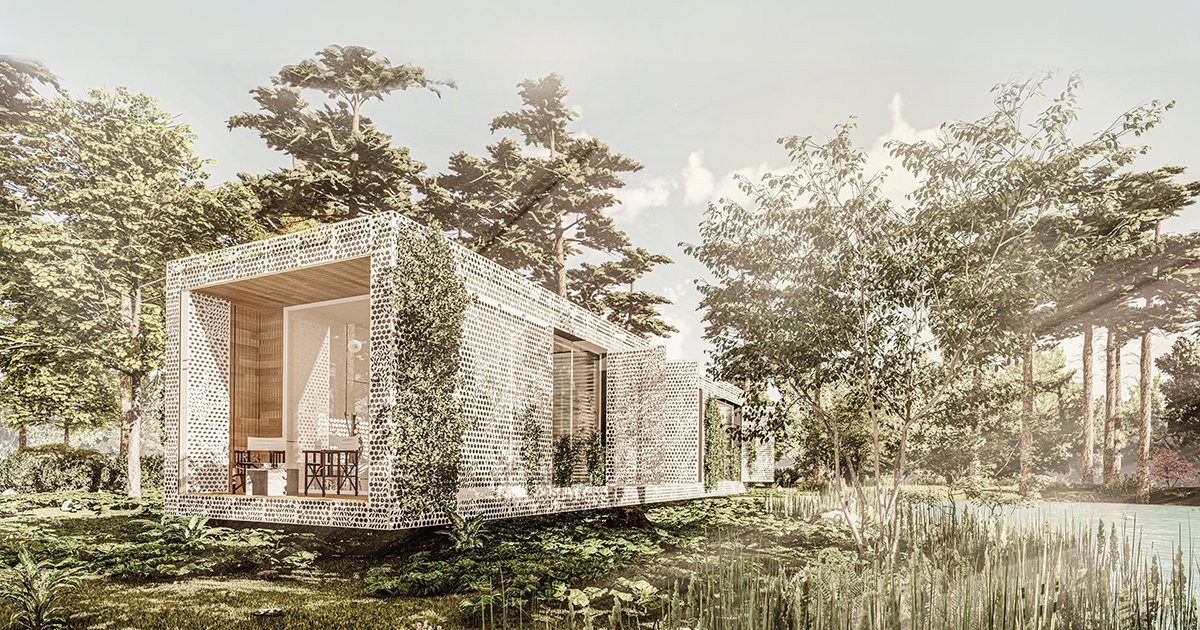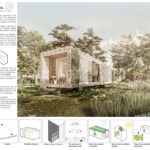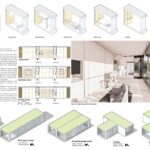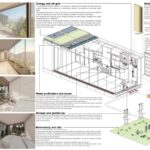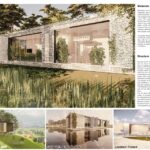Eco Modular House | UArchitects | International Residential Architecture Awards 2022
UArchitects: Winner of International Residential Architecture Awards 2022. Our main vision is that our proposal is a holistic approach regarding the earth eco-system and to improve a long term quality of human life. We support the eco-system with having in mind with a better life in balance with nature and the earth.
In the beginning, mankind started to consume the materials of the nature to cover himself, it was mostly all about the consumption of the earth. By increasing the population, people and communities have increasing problems finding resources.
Now we need to be more careful of what we use like materials, water, food and even the air since there is only one earth. We should consider how we become a part of a nature and not to be a consumer of the nature. Our aim is to protect and enhance the environment and to design with environmental sensitivity in relation to our context and the planet.
’’ Less is more’’ represents the relation of human and environment to have less consumption, negative emissions of CO2, no waste and using reusable materials like wood, steel and glass. Receiving energy of the nature, the sun and the wind. To make a energy neutral living possible. To be able to live off-grid
‘’More in Less’’ is the relation between the human and the using off-grid technology, modular and green solutions outside and less space inside but more functionality and multi flexibility. So that we can do more in a small space.
The idea of the Modular house offers multiple opportunities: modular structure, foldable components with reusable materials, green roof and green façade, off grid-technology, hidden elements which are flexible and adaptable for the user of the Modular house with different layout opportunities regarding the inside space.
Modularity:
Our proposal is the one in which all the components are modular and specific. The modular house, embrace the concept of hidden interior elements.
The aim is to design the generic modular structure elements, each module contains hidden elements inside the wall, which represents different functionalities.
The components (modules) shows its unique functionality and modularity that is very efficient in small spaces and to be used as more furniture in less space. Most of the hidden functions are foldable and be pulled out when it is time to use them like bed, tv, working table, or even the dinning-table.
The size of these generic modules are 120 cm in width and 360 cm high and 420 cm length. Hidden functions of every module are inside of a 60 cm depth and they are usable by folding the doors on the wall to use hidden interior elements. The modules have a green roof and green façade. Also energy storage, water purification, biodiversity, waste compost, reusable materials, pv panels are a part of this modularity design.
Each of module is 120 cm x 360 cm x 420 cm (kitchen, living room, dining room, work area ,bedroom, bathroom and entrance, balcony and one free space)
These modular elements are attached together in order to make different compositions in different sizes from a rectangular shape of 30 m² for a single person by 7 modules, up to 75 m² for a 3 to 4 person family by 15 modules.
The module of the bathroom contains an entrance with a corridor, which is a combination of two modules. The entrance has an important role by transforming the ground plans from rectangle to L shape or T shape one of the many possibilities. The free space module is the last module which enlarge the entrance space.
Biodiversity and site:
Green is the easiest colour for human to view.
Our approach was not just to design a building, but also to re-connect it with the nature and to be productive by creating a small green field site next to the modular house for gardening and producing of fruits, nuts and vegetables for own consumption (composting the human waste into soil to boost the process of the production).
The green field for the food gardening makes people to enjoy the local sense of feeding itself. This is also the part to be able to life off-grid.
We plant also flowers and herbs for the bees, butterflies, birds and insects so that we contribute to the biodiversity, small pool of water will attract also the birds and insects. We give the biodiversity a boost if we are missing this on the location, this boost will always done in relation to the site and the climate.
Materials and façade :
Biobased, environmentally friendly and negative emissions of CO2.
The outside walls are of thermally modified wood. The user can compose the exterior walls according to his own taste and needs.
The materials which are used for the proposal, are wood, aluminium, steel and glass which are reusable. Our main tool was to improve the indoor comfort in every climate, as we propose modular elements which carry the hidden elements in the wooden wall.
The glass façade as the other side of these modules in order to have more daylight and solar gain during the day with ivy façade and perforated steel as a moveable shading system. Each dwelling has its own balcony for each room for having natural ventilation.
we have in our proposal 3 different materials for façade skin:
1-perforated aluminium / steel
2-wood
3-mirror / stainless steel (polished)
The facade has also a sandwich insulation with high insulation value to keep the indoor comfort for a long time.
Each interior wall panel can be finished with the following surfaces:
- Double glass
- Eco board or birch plywood for the walls and ceiling
- Floor whitewash wooden parts or non-slip plywood
General materials:
- Walls: birch plywood or eco board
- Upholstery: thermally or chemically modified wood ( 50 years warranty)
- Insulation: Cellulose insulation
- Roof: EPDM with on top a green roof
- Floor: Non-slip plywood or floor whitewash wooden parts
- Exterior deck of sustainability profiled wooden parts
Energy and off grid
To reach the off-grid solution, we suggest to use a green roof to collect the rainwater and green façade by Ivy plants on hydroponic system and to connect this with a storage water tank.
Generating electricity on your own roof has become extremely simple by the placing of a few pv panels and including also a solar thermal heating collectors heat up the water.
We specified one module as an off-grid storage for solar battery storage and water purification and a water tank.
In some situation a demountable wooden wind turbine can be build up and too much electricity of these wind turbine can also be used to make hydrogen gas and to store this hydrogen gas for heating up the module at dark and cloudy days, when pv panels can not be used.
Water purification and reuse:
Only 0.008 % of global water is readily available for human use.
So water harvesting can be the best solution and next step is to reuse recycled greywater (water from basins, baths and showers) for use in toilet and gardens instead of the high quality drinking water that we commonly use and also to recover heat from waste water too.
The water purification system has 3 stage water filtration, which is for rainwater harvest, well water and river water which are filtering 30 or 45 litres per minute.
The off grid module contains water tank that gets full by harvesting rain water and with the water purification and cooking of the water you can use it for human consumption.
Sewage and gardening:
The entire human waste that enters the toilet is about 90% water. This water is converted to air (moisture) which passes through the ventilation to outside. The other waste which is solid is converted to fertilizer for the garden. A ventilator is used for the odour of the waste which consumes 12 V and from the electricity battery storage of the house.
Structure and adaptable:
Our aim is that our proposal more easy to be portable and we are using reusable material and not to choice for heavy material. We don’t use concrete for this Modular houses. The main structure is made of wooden frame work and re-usable steel which are in cooperated in the modules. When the modules are connected with each other, with this the stability of the structure is made.
Under the modules, there will be steel pillars screwed (reusable) in the ground/soil.
The length of these reusable steel pillars (which are also modular in the length) depends of the quality of the soil (the surface under the Modular house).
The Modular house will placed on these steel pillars and will be lifted up from the ground level or of the water level.
We purpose for an area with change of occasional high rise of water a floatable Modular house which can attached and detached from the steel pillars and can start to float as the water level is rising. This way the Modular house can be relocated again to the land or temporary relocated on the water.
50 years after its construction, an integral reform of the building has been carried out that has allowed the has allowed commercial use on the first 6 floors, keeping the rest of the spaces for office use (65% of the total area).
Given the state of the building, it was necessary to completely empty it, keeping only the structure to undertake a comprehensive reconstruction.
The building’s structure, made up of metal pillars and beams that according to the original project memory were covered with concrete for fire, have also been reformed with generalized reinforcements on the commercial floors and on the office floors where public use is foreseen. With the exception of the central block of elevators and stairs in the tower, the rest of the communication cores have been demolished and their gaps closed, to generate other locations with greater capacity that ensure the evacuation of the building as a whole.
Other far-reaching structural changes have been undertaken as a result of functional conditioning factors in the commercial area, such as the implantation of an opening that connects 5 floors of the building with escalators and that has required the elimination of one of the building’s main beams. This has meant the need to generate new bracing elements, to ensure a correct transmission of loads and horizontal forces that are produced as a result of the new configuration.
Another key aspect of the reform has focused on the facade of the building, protected by municipal regulations. Prior to commencing with the drafting of the façade construction project, research and data collection work was carried out to be able to build a façade with identical characteristics as the original, correcting the modifications that the building had undergone over the years.
The original façade consisted mainly of a curtain wall (stick system) with aluminum mullions and transoms. This curtain wall interspersed glazed panels and blind modules. The glazed panels, which accounted for 40% of the surface of the façade, were mainly composed of glass with a chamber 2.4 m wide by 2.2 m high, although in the lower body and top of the tower it had smaller sized glass sections, 1.2 m wide by 2.2 m high. The type of glass originally installed was commercially called “pink-rose” which provided the characteristic color of the building, especially on cloudy days.
The blank modules were made up of a sandwich panel with hardly any insulation and which had a cast aluminum panel on its outer face for exclusively decorative purposes. This panel was separated a few centimeters from the sandwich panel, held at its 4 ends with specific fixings. In the blind areas of the building, behind the elevator core and emergency staircase, the façade consisted of a non-insulated factory façade, where decorative cast aluminum panels were also installed, which were screwed directly to the masonry closure. In both cases, these fixings did not allow the deforming material to expand in order to absorb the stresses caused by changes in temperature. Therefore, after 50 years, the plates presented numerous pathologies, with considerable warping and bulging, as well as cracks resulting from the impossibility of free dilation. Due to pollution, especially in its first years of life in an industrial Bilbao, the aluminum plates had lost their brightness and natural color of aluminum, being covered by a dark patina of a blackish tone.
As there was no record of the construction process on the execution of the aluminum panels, aluminum smelting factories were visited, where it was concluded that the molten aluminum was poured onto an uncovered chemical sand mold, in such a way that the roughness of its visible face was produced by the retractions of the aluminum when solidifying in contact with the air. It is this roughness and vibrations that give the plate its main formal and expressive characteristic (which in a foundry would be the bad side of the piece).
The original façade underwent a major reform in the 1980s, with the replacement of practically all of the building’s glass due to expansion problems in the façade assembly, which led to several glazed modules falling onto the street. The new glass was placed on a bronze-colored aluminum carpentry attached to the original curtain wall and secured exclusively with structural silicone. The original glass of the first 6 floors of Gran Via street was kept, so it was possible to verify the differences between the original glass of a more pinkish color and those installed in the 80s with a more orange color. In both cases, the layer of solar control that they have made the perception of these and their tonality vary depending on the time and the incidence of solar rays.
Given that some of the original glass remained on the Gran Vía façade, it could be used to exactly reproduce the original color, manufacturing the solar control layer with a state-of-the-art magnetron. The end result has been a façade identical to the original, but very different from the image that the building offered prior to renovation.
On the ground floor, the façade pillars have been covered with marble, identical to the original and the panels between them have been closed with large glass and hidden profiles that avoid detracting from the façade. The entrance to the commercial zone is from the public square in front of the building. Access to the office area is through Gran Via street, as was the case prior to the renovation. The lobby is smaller lobby as the space of the ground floor has been given over to commercial space.
Inside, there were practically no outstanding original elements, as the building had undergone numerous interior renovations throughout its life. Designing an entrance according to the tower was another challenge of the project, especially given the geometry of the existing, narrow and elongated space that could generate a tunnel effect. In addition, in this space beside the street, there are three evacuation exits and access to two service elevators for the commercial premises, two ATMs and access for maintenance. For this reason, it was decided to divide this lobby into two areas, one outside as a hallway where the spaces described above converge and then the lobby itself with its reception area, elevator block and waiting room.
The strategy focused on integrating and concealing all the existing elements on the walls, especially the doors. For this, a square section corrugated sheet was designed, which concealed the hinges, joints and fittings of the doors, offering a clean image of this space. This sheeting was placed both on the ceiling and on the walls, using white lacquered steel on the inside and anodized aluminum on the outside hallway.
On the interior floor, white marble was installed, therefore, together with the white corrugated sheet a very bright interior space has been configured. Bush hammered granite has been used on the exterior floor, and together with the anodized aluminum, forms a gray ring that further enhances the interior white. The white marble of the floor, laid out following the rhythm and configuration of the frets, was also placed in the lower half of the reception panel, to form the furniture in this area and frame the access to the waiting room. Green marble is used in the waiting room, identical to the exterior pillars, both on the floor, walls and ceiling and which is accessed through a corridor with Estremoz white marble on the floor, walls and ceiling. The encounters have been taken to the corners and diagonals to generate different geometric and formal readings of the space. Lastly, there is the elevator core configured as a golden block formed by gold stainless steel panels, as a nod to the building that was the headquarters of one of the most important banks in Europe. On the contrary, the elevator lobbies of the rest of the floors have been configured as white boxes with perforated sheet metal with sound-absorbing sheets on the walls and a gray floor, made of micrograin terrazzo or self-leveling mortar.
The office floors have been designed using the Core and Shell concept and all the installations are close and ready to be connected, except for the fire protection installation that has been completely installed. In the original vaults, warehouses of a special character were created, keeping the armored doors and enhancing the original concrete walls. These spaces have been complemented with warm elements such as carpeting, wood and sound absorbing felt slats or perforated sheet metal panels, trying not to completely lose the original character of the building.

Project Details
Firm
UArchitects
Architect/Designer
Misak Terzibasiyan
Project Name
Eco Modular House
International Residential Architecture Awards Category
House Design Concept
Project Location
The South of the Netherlands
Team
Misak Terzibasiyan
Country
Netherlands
Photography ©Credit
©UArchitects
 UArchitects and Misak Terzibasiyan
UArchitects and Misak Terzibasiyan
The founder and principal Architect of UArchitects, Misak Terzibasiyan, is personally and professionally focused on an international context as well as on the influence of cultural themes. This is mainly based on his ethnical background, as Misak Terzibasiyan was born in Helsinki (Finland).
UArchitects is an international studio that welcomes different nationalities. Our investigative attitude is expressed in the intensive dialogue we undertake with our clients. The scope for reflection is not confined to the projects themselves; we also look into the wider cultural context of architecture and urban development. We are making a social contribution, investigating the position and responsibilities of the architect.
He is the author of the book: Experience and Meaning of Architecture (2021) and Experience of Architecture and Art “An Architect’s Journey” (2022).


